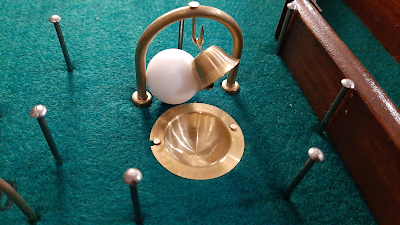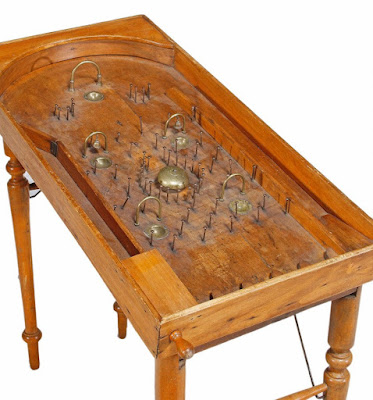Check out this full bagatelle restoration by Old Things Never Die
I guess I buried the lede there. I was able to purchase this table from the restorer, and it has safely arrived from France.
Ball sizes
The game arrived with ~19.9mm steel balls, approx 25/32". This would require a very full plunge to get some action from the spring plunger. Steel balls would also not be good to launch with a cue from the right lane.
I tried 7/8" balls, which are 22.23mm, but those were too large. If one ball was in a brass cup, another could be caught between the ball and the gate post. I tried plastic balls and marbles, and using light balls made the plunge much better.
I have begun using 3/4" marbles. That works fine for now, but 3/4" is 19.05 mm. I would like to try and find some more appropriate balls that get up to the 19.9mm size, if possible
 |
| 22.23mm (7/8") is too big |
On the topic of "restoration"
Restorations are often a contentious topic within collector circles. Original everything is always the most desired, and complete restorations are sometimes seen as gauche. "It's only original once."
The historian angle would be to always leave things as-is. We're literally destroying history!
When it comes to the collector angle, especially for ARCADE collectors, you want the thing to work first and foremost. Most of us game collectors don't collect things just to have them to sit inert on a shelf and take room. We want them to work. Even if we don't play with them regularly, the thought of a machine that isn't fully operational scratches at the back of your mind. A broken game can haunt you until you decide to spend the time on it, or sell it in frustration to make the haunting end.
There is a small market for high-end pinball restorations. The people who can achieve that quality are few and far between, and generally the results have to be "like new or better" for the recipient for a restoration to enter that stratosphere. These machines have lost all of the pockmarks of history when done.
This machine would fall under that category, where the restoration is absolutely beautiful, but it is no longer an early 1900s toy, it's now a full modern restoration of one. And that's a huge conceptual difference.
The pockmarks of history that defined this game's journey over the last 100 years have been sanded down and refinished. And personally I am totally fine with that in this specific scenario, for a handful of reasons.
- This machine was arbitrarily selected by the youtuber for restoration. It was an antique item selected to make good content. What's done is done, and if it was going to happen, I am grateful I get to receive the benefits of that labour, because
- This is an excellent machine to share with people. I very much look forward to bringing this to shows as a demonstration of the history at hand. Would I have preferred a copy of this table in immaculate condition but entirely original? Sure, of course. But that was not readily available, and original items often come with their own headaches when it comes to outreach and education.
- There is a bonus perk here, with the fame of the youtube channel. Restoration youtube is a hot category, with many people producing regular videos where they rework antique items. Being able to show people this video in the background will be able to draw more people into its history. It also showcases the possibilities of traditional table games! So many of the games we write about in the 18th and 19th centuries can be readily created by hobbyists in a small shop, and that's an idea I'd like to see grow again.
- I am not worried about population numbers for this table. It was sold at a fancy Parisian toy store and there are many known existing copies, so I don't harbor any guilt over its fate. A converse example of this would be the King Kong pinball machine by Data East. 9 prototypes were built, and almost all of them have undergone high-end restoration to make them playable and reliable. The original state of those tables is gone, but in most cases interventions were necessary to make them even modestly playable. A current example in the pinball community would be the failed JPop Magic Girl prototype. One exists and it's mostly an unplayable box of lights. Will the owner attempt to "finish" it? Or leave it as a fancy-looking paperweight? What are the ethics involved in the choice?
My friend James Masters (of TradGames.org.uk) found he had 2 of these models in his storage:
 |
| There are always variations. These two appear to have never had felt on the playfield, and as well only one appears to have had legs. (though the leg hardware is now missing) |
 |
| plunger is missing on the left |
 |
| via liveauctioneers |
These were all fancy toys, smaller mockups of the grand French Bagatelle Tables whose craftsmanship could rival the best in billiards.
Another restoration of note:
Here is a similarly styled restoration video for a slot machine. This video can get the hairs of slot collectors standing on end with the way some of the materials are treated. A collector would very much try and leave it as-is, and there are even some steps that a "slot machine restorer" would probably do very differently here. I still think it's an interesting breakdown of the machine's parts and a relaxing watch.

No comments:
Post a Comment